The Kabbalah, the Tarot and the Middle Way
Kenneth Chan
10. Opening the Door to Yetzirah
With the attainment and adequate development of both Binah and Chokmah, the stage is now set for the most important step in the Tree of Life in Assiyah, the one that opens the door to the higher Tree of Life in Yetzirah. This is the 14th Path which is described as follows:
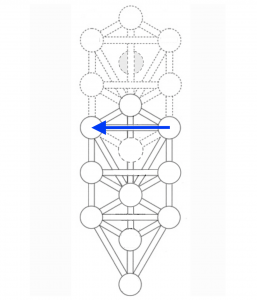
The 14th Path: Chokmah – Binah
“The Fourteenth Path is the Illuminating Intelligence and is so called because it is that Chasmal which is the founder of the concealed and fundamental ideas of holiness and of their stages of preparation.”
Hebrew Letter: Daleth. Door.
Tarot: The Tower
As the Yetziratic text clearly implies, this is the crucial threshold; and the Hebrew letter assigned to it appropriately means door. It is the door to the next higher World of Manifestation, known as Yetzirah.
The Yetziratic text also calls this Path 14 the Chasmal, which when traversed reveals “the concealed and fundamental ideas of holiness and of their stages of preparation.” It is the Chasmal because these concealed and fundamental ideas will remain hidden until the threshold is crossed. Upon crossing the threshold, however, the door will open and reveal Daath, the hidden Sephirah straddling the central path upwards. When thus revealed, Daath will function as Yesod in Yetzirah, and will provide us with the direct mystical experience of the “fundamental ideas of holiness” which refer to the oneness of all beings and the oneness of all phenomena, as well as the realization that the self is empty of inherent existence.
Once it is crossed, this path becomes the Illuminating Intelligence, which shows the way. When Daath is revealed, the long journey across the abyss from Tiphareth to Kether is broken into two stages, allowing it to be traversed. Hence it is the founder of “their stages of preparation.”
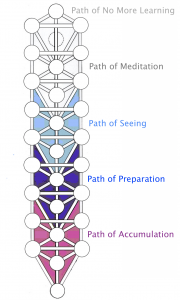
With remarkable synchronicity, we note that, in Vajrayana Buddhism, this stage of our spiritual quest, represented by the journey that takes us via the revealed Daath through to Kether (in Assiyah), is known as the Path of Preparation. In certain Tibetan Buddhist traditions, it is also known as the Path of Joining, since it joins the Path of Accumulation to the Path of Seeing. We can also understand this now as referring to the joining of the two stages—the path, from Tiphareth to Daath, to the path from Daath to Kether. And this is made possible by the revealed Daath that appears after we open the door to Yetzirah by crossing this crucial threshold from Chokmah to Binah.
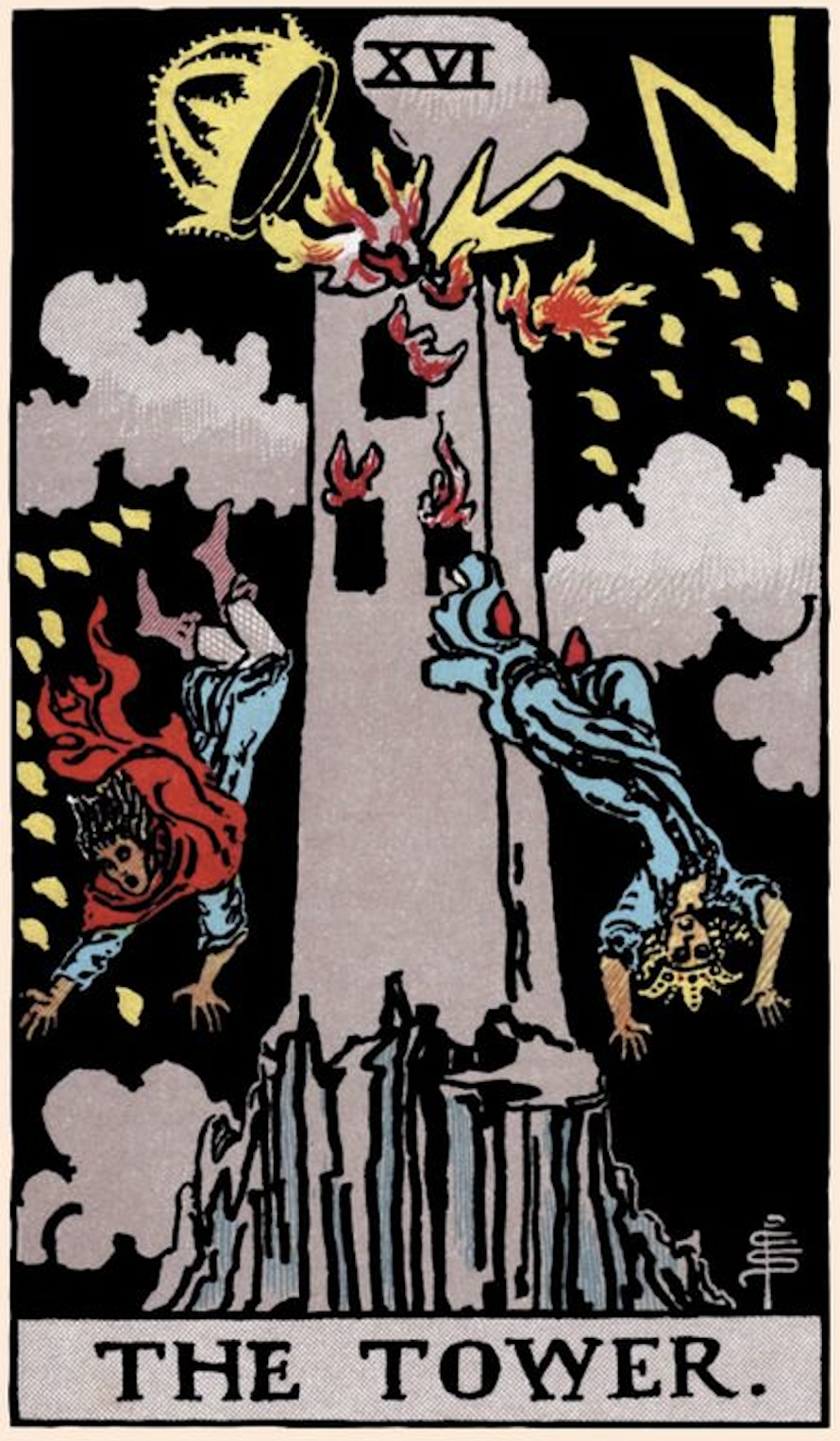
This path from Chokmah to Binah is also depicted by the Tarot card, The Tower. Neither the Yetziratic text nor the Hebrew letters assigned to the Tree in Asiyyah gives real clues as to what this path actually represents. The crucial key lies in the Tarot card, The Tower. Here, it is symbolized by a tower being struck by lightning, knocking off the crown at the top and flinging the people out. This dramatic picture represents our commitment to relinquish our ego, the abandonment of our concern over the image of the self.
Generally, prior to this stage of our spiritual journey, we are obsessed with the image of our self, how we and others view us, and almost all our waking moments are focused on how to promote this image. Most of our energies are targeted at nurturing this self-image, our reputation, the image that we project to others, our self-respect and so on. Even when we do things to benefit others, the image of our own self performing this good deed is clearly set before us, and we are constantly monitoring how we are compared to others. The barrier we now have to cross is to abandon this incessant concern over this self-image.
The Tarot card, The Tower, dramatically portrays the demolition of the ego. The crown and the tower, depicted on the Tarot card, are artificial and should not have been there in the first place; it is rightly being destroyed by a natural force, the lightning. The people flung out could represent both a freeing process, as well as the discarding of the sense of individuality, the sense of a separate self. With the relinquishment of the ego, and the loss of the intellectual sense of self, Daath is revealed and now the door to Yetzirah is open.
In order to achieve this crucial step, we need to take the path from Chokmah to Binah, which represents the combination of our intent to incorporate, in our daily activities, the understanding that the self is empty of inherent existence (represented by Chokmah), with the realization of the essential nonseparation of our self from others (represented by Binah). It is this combination that will enable us to take the crucial step to relinquish our self-image, the ego that we have, so far, focused upon and nurtured almost constantly.
It is this commitment to relinquish our self-image that enables us to reach within our depths onto the touchstone of reality, the very secret of our being, and allows us to grasp the essential mystery of the inner light. That is why it is the crossing of this crucial threshold that will reveal the hidden Sephirah, Daath, so that it now functions as Yesod of the next higher Tree of Life in Yetzirah. And this revealed Sephirah now forms the bridge across the “Chasmal which is the founder of the concealed and fundamental ideas of holiness and of their stages of preparation.”
It is important to realize, however, that the relinquishing of our ego does not mean that we become docile and insipid. The opposite is true, since our motivation to build our self-image will then be replaced by the motivation to save all beings from suffering, and this becomes an even more urgent undertaking. This is an important transformation of our being upon entering the World of Yetzirah, and it explains why compassion is a crucial component of the spiritual path.
To progress higher on the spiritual path, it is crucial that we cross this threshold between Chokmah and Binah, for it represents the second of the four obscurations to Buddhahood given by the Uttaratantra Shastra. The passage from this scripture reads:
Enmity towards the Dharma,
A view asserting an existing self,
Fear of samsara’s suffering,
And neglect of the welfare of fellow beings
Are the four veils …
Thus, it is the “view asserting an existing self” that has to be abandoned to cross this threshold. And the remedy for this second veil is given by the second line in this passage from the Uttaratantra Shastra:
Those whose seed is devotion towards the supreme vehicle,
Whose mother is analytical wisdom generating the Buddha qualities,
Whose abode is the blissful womb of meditative stability,
And whose nurse is compassion,
Are heirs born to succeed the Muni.
The “analytical wisdom generating the Buddha qualities” refers to the path from Tiphareth to Chokmah, represented by the Tarot card, The Moon, that we have already discussed. Recall that it is the path where we apply the Right Intention to live in accordance with the wisdom realizing emptiness. This then is the remedy to the “view asserting an existing self” which is the second of the four veils to Buddhahood.
In summary, it is this act of relinquishing our ego that is the key to the door to Yetzirah. And by opening this door, represented by the path from Chokmah to Binah in Assiyah, we can now take the path from Tiphareth to Kether. The Yetziratic text describes this path as follows:
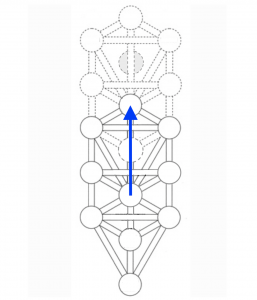
The 13th Path: Tiphareth – Kether
“The Thirteenth Path is named the Uniting Intelligence, and is so called because it is itself the Essence of Glory; it is the Consummation of Truth of individual spiritual things.”
Hebrew Letter: Gimel. Camel.
“Uniting Intelligence” clearly describes the realization of oneness. In the line “the Consummation of Truth of individual spiritual things” the crucial word is “individual.” This is the highest truth for the individual spiritual things because, after attaining the realization of nonseparateness, they simply cannot be considered as “individual” anymore. In other words, the realization that the self is empty of inherent existence breaks down all the barriers between the self and others. There is now, in fact, no self and no others to be considered separate. This realization leads to the unitive experience where the sense of separation has dissipated, and we become one with the All.
Let us look more closely at how this process unfolds. This 13th Path actually represents two stages, the path, in the Tree of Life in Yetzirah, from Malkuth to Yesod (which corresponds with the path from Tiphareth to the revealed Daath in the Tree of Life in Assiyah), and the path, in Yetzirah, from Yesod to Tiphareth (which corresponds with the path from the revealed Daath to Kether in the Tree of Life in Assiyah). The first stage of this path, from Malkuth to Yesod (in Yetzirah) is represented by the Tarot card, The World, and is designated by the Noble Eightfold Path as the Right View:
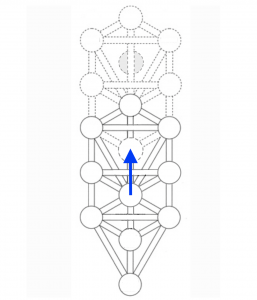
YETZIRAH: Malkuth – Yesod
Tarot: The World
Noble Eightfold Path: Right View

The Tarot card, The World, shows a lady in her pristine state, free of embellishments, that depicts a state of naturalness, within a garland ring, that depicts a state of binding unity. It represents a unitive state of natural oneness with the All. The four Living Creatures of Ezekiel that occupy the four corners of the Tarot card—man, eagle, lion and ox—represent all sentient beings. The man represents humanity, the eagle represents the birds, the lion represents the wild animals, and the ox represents the domesticated animals. This tells us that the binding unity of oneness depicted in the Tarot card is a unitive state of all sentient beings.
The Noble Eightfold Path designates this insight on the unitive state of all beings as that of the Right View. It is this realization of the oneness of All, the state of nonseparation, that takes us on the path to the newly revealed Sephirah, Daath, which now functions as Yesod in the World of Yetzirah.
The Hebrew letter for the path from Tiphareth to Kether (in Assiyah) means “camel.” It depicts a long journey across a desert that is now made possible by the revelation of Daath, which now functions as an oasis that enables us to make the journey.
There is no description of this formerly hidden Sephirah, Daath, in the supplement to the Sefer Yetzirah, but the description of its virtues in the Western mystical tradition is as follows:
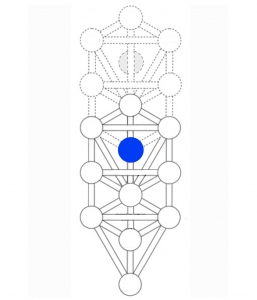
DAATH – KNOWLEDGE
Virtues: Detachment. Perfection of Justice and the application of the Virtues untainted by Personality considerations. Confidence in the future.
Spiritual Experience: Vision across the Abyss
The revealed Daath, which is Yesod of the Tree of Life in Yetzirah, represents a mystical experience that enables us to actually feel temporarily what it is like to be in a higher spiritual state. It is a state of intense bliss and profound realization. We are being shown, at least for a while, what it is like to be higher spiritual being.
The words describing the Virtues of this Sephirah, Daath, is an almost perfect description of this unitive state of bliss that results from the loss of the sense of self. We are in a state of detachment because there is no longer a “self” to claim possession of things, including our reputation, or even a self-image to be concerned about. Since all beings are one in a unitive state of nonseparation, there is naturally the “Perfection of Justice.”
This realization requires a mind that is receptive to it, and that is why the combination of the qualities represented by Chokmah and Binah is necessary. This explains why it is described as “the application of the Virtues untainted by Personality considerations.” These words may also be taken to mean that, in the unitive state, there is complete sharing, love and compassion, and that “personality” is certainly no longer relevant when we have lost the sense of self.
An experience of this kind, which is a state of profound bliss, would certainly give one “confidence in the future.” It, in fact, does much more than that; it now becomes the driving motivation for the spiritual path. This powerful mystical experience is felt almost like a force, and is now the inspirational fire that will propel us forward across the chasm and onto Tiphareth of the World of Yetzirah. It is essentially an inspirational signpost that clearly points to us the way to proceed on our steep climb to the stars and beyond.
The mystical experience, that the revealed Daath represents, is also the realization of an underlying transcendence that pervades everything. The loss of the sense of self comes with a sense of blissful spaciousness, a sense of a diffused transcendence of idyllic insight that stretches to the infinite reaches of the All. It is an ocean of bliss infused with the passionate touch and sweet embrace of motherly compassion.
This realization emerges when we lose the sense of self and realize that all things are empty of inherent existence. It is a sense of the Tao, the uncreated, or unoriginated, that cannot be defined in concrete terms, since any attempt to do so would incorrectly imply that it is a separate inherently-existing entity, which it is not. It is, in a sense, the all-pervading pantheistic God in Western Mysticism, which is not considered as a separate entity from everything else.
It is the “One” that Plotinus, the founder of Neoplatonism, considers as the first principle, which is indescribable directly. Plotinus taught that there is a supreme, totally transcendent “One,” which contains no division, multiplicity, or distinction; and is beyond all categories of being and non-being. This “One,” according to Plotinus, “cannot be any existing thing,” nor is it merely the sum of all things, but “is prior to all existents.”
In Buddhist terms, this realization, in the mystical experience of Daath, would be best understood to be a sense of the experience of sunyata when we have realized that all things are empty of inherent existence and are only dependently arisen. That is why the experience of the wisdom realizing emptiness comes with a sense of spaciousness. It is the sense of what “remains” after realizing that all things are empty of inherent existence (meaning that things do not exist independently on their own right). This sense of what “remains” cannot be defined since any attempt to do so would wrongly suggest that it inherently exists. In Tibetan Buddhism, it is the experience of what is known as the Conventional Truth, that informs us that emptiness does not mean nihilism. There are still appearances and functionality, which is not an illusion, although it is like an illusion.
There is remarkable synchronicity between the qualities of the “One” described by Plotinus, and the experience of sunyata that is described by the Madhyamika philosophers when the wisdom realizing emptiness is achieved. The reason for this, in all likelihood, is because they have all encountered essentially the same mystical experience. Plotinus, known as a mystical thinker, refers to the concept of attaining an ecstatic union with the One, a mystical state called henosis, and his student, Porphyry relates that Plotinus attained such a union four times during the years he knew him.
The “concept” of the One is actually not a concept at all since Plotinus never explicitly defines the “One.” Even the name “the One” is, in a sense, inappropriate, for naming already implies discursive knowledge, and the One cannot be known through discursive reasoning or analysis. Even the “power” of the One is not a power in the sense of physical or mental action. The power of the One, according to Plotinus, is to be understood as a description of the “manifestation” of a supreme principle that, by its very nature, transcends all discursive understanding and intellectual analysis.
This transcendence of all discursive analysis is echoed in the tradition of Dzogchen (which belongs to the Nyingma tradition of Tibetan Buddhism) in the experience of rigpa, the pure pristine awareness that is free of all distorting elaborations and imputations. This is also echoed the famous words of the Tao Te Ching:
The Tao that can be told is not the eternal Tao.
The name that can be named is not the eternal name.
The nameless is the beginning of heaven and earth.
The named is the mother of ten thousand things.
In Madhyamika philosophy, this sense of oneness and nonseparation is not even named. That is because once it is labelled, the incorrect notion that it is an inherently existing entity is implied, and that would be an incorrect understanding. It is a sense sometimes described as the “one taste” and can be intuited from an understanding of what is known, in Madhyamika philosophy, as the Conventional Truth.
There are two truths in Madhyamika philosophy: The Ultimate Truth and the Conventional Truth. Both are correct and have to be realized. The Ultimate Truth is the fact that all things are empty of inherent existence. The Conventional Truth is the fact that, even though all things are empty of inherent existence, we do not have a state of nihilism. This is because appearance and functionality still “manifests” before us.
We need to realize the Ultimate Truth before we can fully realize the Conventional Truth. It is the sense of what “remains” after the realization that all phenomena are empty of inherent existence. The Conventional Truth is thus found in the experience of sunyata, and is related to the words of the Madhyamika masters that our reality is “like an illusion.” This does not mean that it is an illusion, but only that it is like an illusion. And the experience of sunyata is a profound and blissful sense of spaciousness and transcendence.
What we have here, in the newly revealed Sephirah, Daath, is thus a taste of this underlying transcendence that pervades everything although the full intensity of the experience of sunyata can only be reached after we directly attain the wisdom realizing emptiness. Likewise, the full experience of henosis (or mystical “oneness” as according to Plotinus) can only be experienced after we have achieved what is essentially the loss of the sense of self. Nonetheless, here, in the newly revealed Daath, we have an initial temporary taste of this underlying pervasiveness of the “One.”
This profound experience develops an inner flame that glows within our deep consciousness. It will help us reach out towards the starlit horizons of our spiritual quest. The mystical experience of Yesod is thus a force of inspiration, one that can propel us to Tiphareth in the World of Yetzirah, and beyond.
This inspirational power begins by affecting Hod and Netzach (of Yetzirah). The path from Yesod to Hod is depicted by the Tarot card, The Sun.
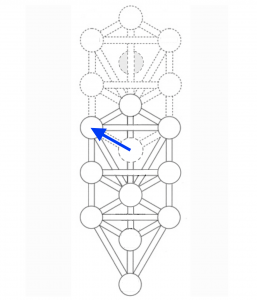
YETZIRAH: Yesod – Hod
Tarot: The Sun
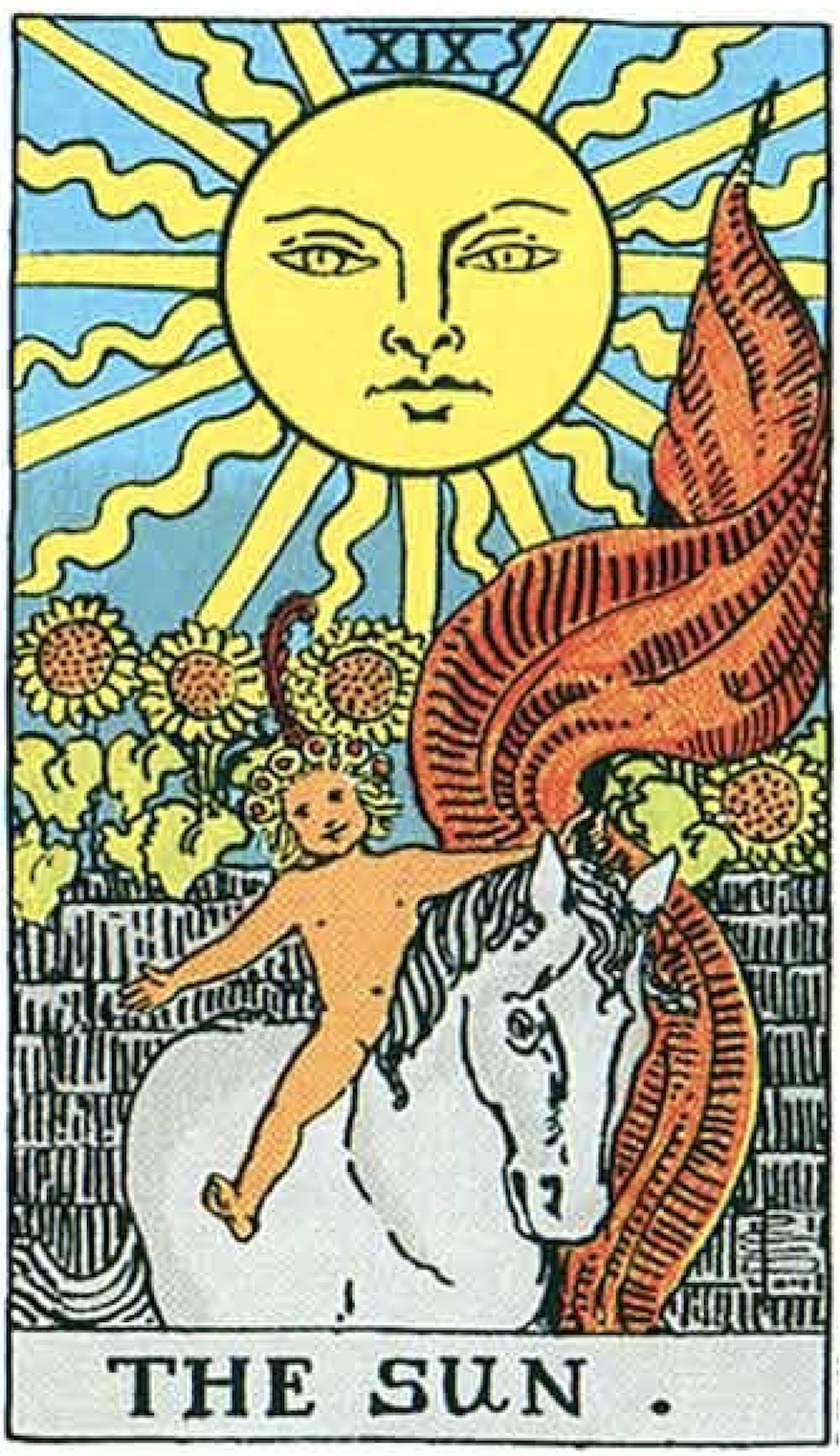
This path from Yesod to Hod, in the World of Yetzirah, depicts how the inspirational mystical experience, at the newly revealed Yesod, affects our core reference perspective, the foundation upon which we base our thinking and actions in daily life. The Tarot card, The Sun, thus depicts the path of transforming Hod in accordance with the mystical experience at Yesod.. A direct encounter with the unitive experience where we feel the all-encompassing transcendence of the One would naturally lead to a sense of nonseparation with the All.
This is perfectly illustrated in the Tarot card which depicts a child riding away from a wall, happily and triumphantly, under the blessings of the sun, It symbolizes how the experience of the mystical state has broken down more barriers between the aspirant and others. The child, a symbol of purity and natural innocence, also represents the fact that this transformation is a natural one that is occurring without the embellishment of discursive thinking or intellectual analyses. It is a transformation of the very essence of our reference perspective because it stems from a direct experience of the state of oneness and nonduality, which is what emerges after losing the sense of self. We experience this truth directly; it is not something imparted to us through logical reasoning or intellectual analysis. The reason why it is so crucial to reveal the formerly hidden Sephirah, Daath, is that it allows us to gain this realization through direct experience. It is this inspiration flame that now leads us onwards in our spiritual quest.
The mystical experience at Yesod has a similar effect on Netzach, the emotive and aspirational aspect of our being. This is depicted, in the path from Yesod to Netzach, by the Tarot card, The Star.
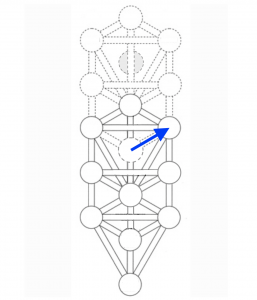
YETZIRAH: Yesod – Netzach
Tarot Card: The Star
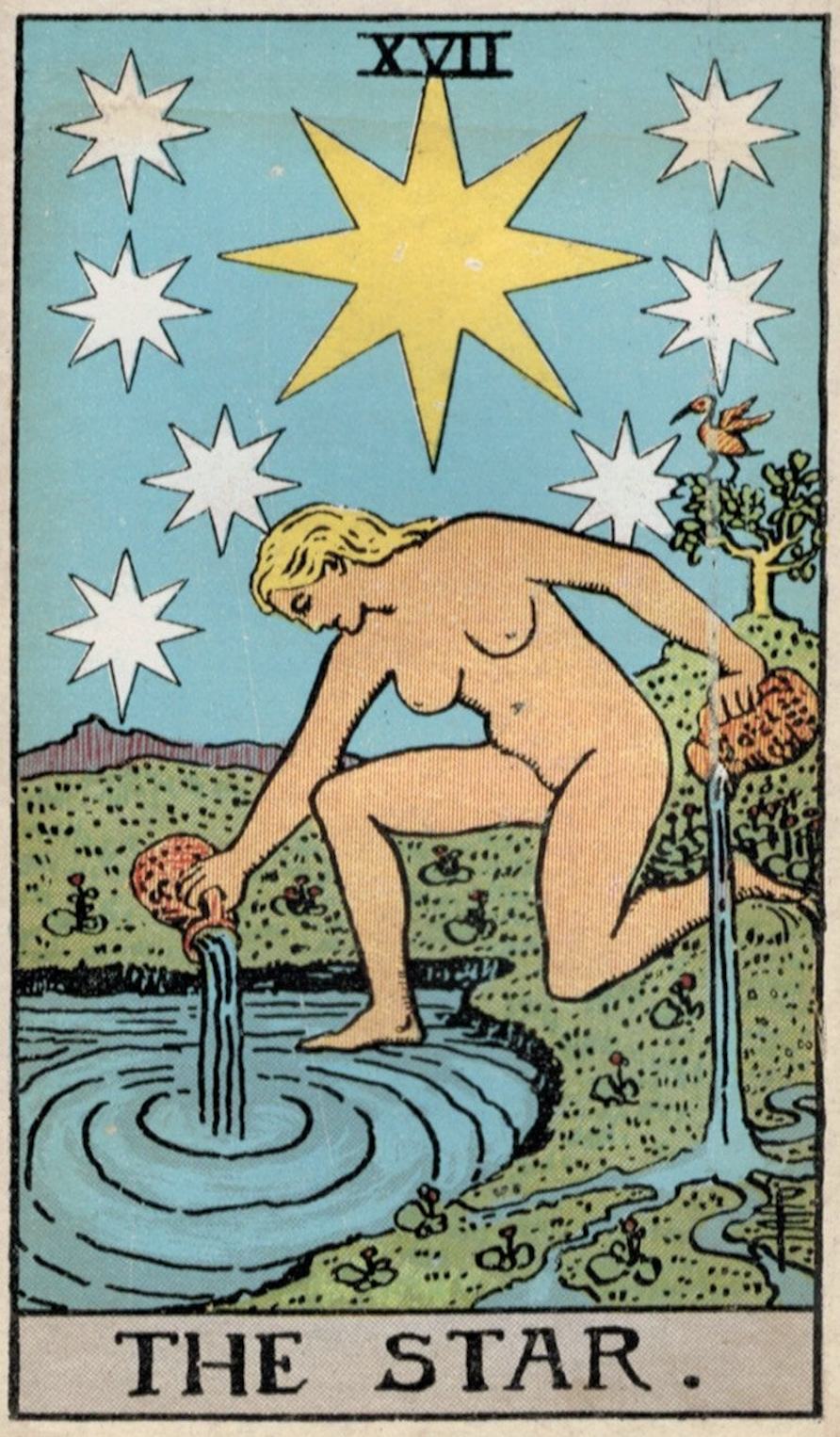
The mystical experience at Yesod would naturally fire up our inspiration to strive onwards in our spiritual quest. The Tarot card, The Star, shows a lady in her natural state, naked and free of embellishments, pouring water onto both the waters and the dry land. This act signifies a process of unifying both the land and the lake, for if this is continued indefinitely, they will both be the same. It depicts a process of bringing about a state of nonduality, and the realization of this spiritual truth of oneness arises from the mystical experience of a transcendent nonseparation at Yesod.
The transformation of our aspirational being is also depicted as a natural one, not embellished or complicated by intellectual arguments and reasonings. That is why the lady is naked and in her natural state. This is because the transformation comes from a direct experience of the truth, and not one brought about by discursive reasoning.
Like the description by the Yetziratic text for Yesod in the World of Assiyah, the mystical experience here is also one that “purifies the Emanations.” The words depicting Yesod in Assiyah also applies here: “It proves and corrects the designing of their representations, and disposes the unity with which they are designed without diminution or division.” This is because both function in the same way and now deliver a realization of what has previously been represented, via discursive reasoning and even via the diagrams on this Tree of Life, through a direct experience of the truth. In other words, we now know because we have actually lived it and experienced it directly.
The Tarot card also shows a bird ready to take flight to the stars. The direct mystical experience now becomes the inspirational flame that will propel us ever onwards in our spiritual quest. Because of the intense and profound bliss of the mystical experience, we will also have realized that the mundane pleasures of life all actually pale in comparison with that found on the spiritual quest. We know now that there is nothing more worth doing than to strive ever onwards in our spiritual quest and head for the stars.
With this transformation of Chokmah in the World of Assiyah, we are now ready to make the final part of our journey onto Kether, and into the World of the Limitless, thus unveiling the second of the three Veils of Negative Existence, Ain Sof.
Copyright © 2021 by Kenneth K C Chan. All Rights Reserved.